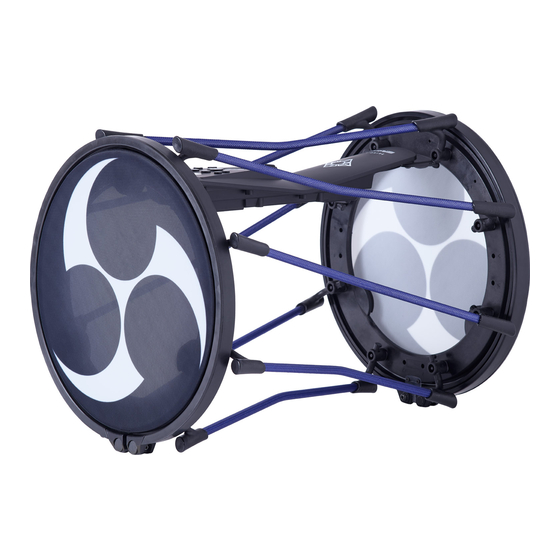Table of Contents
Advertisement
Quick Links
Owner's Manual
Read this first. It explains the basic things you need to know in
order to use the TAIKO-1.
PDF Manual
(download from the Web)
5 TAIKO-1 Reference Manual
This explains all functions and parameters of the TAIKO-1.
Before using this unit, carefully read "USING THE UNIT SAFELY" and "IMPORTANT NOTES" (the leaflet "USING THE UNIT SAFELY" and the Owner's Manual (p. 2)).
After reading, keep the document(s) where it will be available for immediate reference.
© 2020 Roland Corporation
(this document)
Owner's Manual
To obtain the PDF manual
1.
Enter the following URL in your
computer.
https://www.roland.com/support/
I
2.
Choose "TAIKO-1" as the product name.
Advertisement
Table of Contents

Summary of Contents for Roland TAIKO-1
- Page 1 5 TAIKO-1 Reference Manual This explains all functions and parameters of the TAIKO-1. Choose “TAIKO-1” as the product name. Before using this unit, carefully read “USING THE UNIT SAFELY” and “IMPORTANT NOTES” (the leaflet “USING THE UNIT SAFELY” and the Owner’s Manual (p. 2)).
-
Page 2: Using The Unit Safely
Bluetooth the extraneous sounds produced when it’s • Disassembling or modifying this device. SIG, Inc. and any use of such marks by Roland is played. However, since sound vibrations can • Removing the certification label affixed to under license. -
Page 3: Table Of Contents
......Performance : Using the TAIKO-1 to Hear Music Played from a : Rear Panel . -
Page 4: Assembly
If necessary, spread out a blanket or similar material to prevent the * When attaching the sound module, take care that you are not TAIKO-1 or floor from being scratched during assembly. injured by an rubber ring. 1. Attach the rods to the pad 2-1. -
Page 5: Attaching A Strap
Specifying the pads to use (Active Pad) 3. Pull the rods out of the pad The TAIKO-1 lets you use both pads, but if you want to use only 3-1. Taking care not to apply excessive force one pad, you can enable just one pad. -
Page 6: Panel Descriptions
About the bachi (sticks) to use Use commercially available sticks sold for a “katsugi okedo daiko. ” * When playing the TAIKO-1, do not strike any location other than the surface or rim of the pad. (Do not strike the rods or the sound module.) Doing so will cause... -
Page 7: Rear Panel (Connecting Your Equipment)
USB COMPUTER port Factory Setting: Connect your computer to the TAIKO-1’s USB port via USB cable. You can use EXP PEDAL 1 to control the overall volume . * Do not use a micro USB cable that is designed only for charging a You can use EXP PEDAL 2 to control the volume of the “ji-uchi. -
Page 8: Getting Ready
Turning off the power If you continue to use the unit in this state, the display will indicate “Battery Low!, ” and finally the TAIKO-1 will stop functioning entirely. 1. Power-off the equipment in the order of the connected devices 0 TAIKO-1 (long-press the [L]... -
Page 9: Basic Operation
Getting Ready Changing a value Basic Operation ([-] [+] buttons) Function settings (F1/F2 buttons) F1 button F2 button These buttons execute the functions that are shown in the lower part of the display. [-] [+] buttons The function that are shown vary depending on the screen. Use the [–] [+] buttons to change the value that is highlighted by the * In the explanations shown in the owner’s manual, these buttons cursor. -
Page 10: Playing
Selecting a Sound (Kit) What is ji-uchi? The TAIKO-1 assigns separate sounds to the head and rim of the two pads. These four sounds are collectively called a “kit. ” Ji-uchi is the basic rhythm of the song. There are 50 preset kits. By switching kits, you can perform using a The ji-uchi is struck like a metronome, and the song is played in variety of different sounds. -
Page 11: Recording (Rec)
Playing Parameter Value Practicing (Practice) Explanation [H] [I] button [+] [-] button Specifies the tempo of the This lets you practice keeping the tempo with your body. Tempo 20–260 metronome. For the first few measures, the click is heard at the specified volume, Specifies the time signature but for the next few measures the click is not heard. -
Page 12: Using The Bluetooth® Functionality
8. Tap “TAIKO-1 Audio” that is shown in the Bluetooth device screen of your mobile device. This unit is paired with the mobile device. When pairing succeeds, “TAIKO-1 Audio” is added to the list of “Paired Devices” on your mobile device. The TAIKO-1 screen will indicate “Connected (Audio). ”... -
Page 13: Making Overall Settings For The Taiko-1
(Factory Reset) such as specifying the output destination of the TAIKO-1, and making footswitch assignments. Here’s how the settings that you edited and saved on the TAIKO-1 can 1. Press the “MENU” be returned to their factory-set condition. (F2 button) * When you execute this operation, all saved settings including the 2. -
Page 14: Main Specifications
EXP PEDAL jacks x 2: 1/4-inch TRS phone type time that the document was issued. For the latest information, USB MEMORY Port x 1 refer to the Roland website. USB COMPUTER jack (MIDI) x 1: USB Micro B type DC IN jack x 1...









Need help?
Do you have a question about the TAIKO-1 and is the answer not in the manual?
Questions and answers